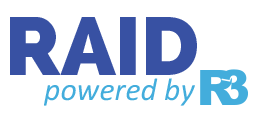RAID level 1 is a fault tolerant array of hard disk drives. A RAID 1 array may consist of two or more hard disks with an overall capacity no greater than that of the smallest member hard disk. In many ways the simplest of RAID levels, there are no restrictive overheads in generating the data.
A RAID 1 volume is often referred to as a mirrored array with the process known as ‘mirroring’, this is because an identical (mirror) copies of the data written to the volume as a whole are written to each member disk in the array. This allows for the continuation of the volume should a member fail, giving the user the opportunity to replace the failed hard disk and rebuild the data on the replacement. A typical two disk RAID 1 diagram of data storage can be seen below:
RAID 1 can also be adapted for fault tolerant high performance throughput by combining RAID 0 arrays into a mirror, this level is know as RAID 1+0 (sometimes referred to as RAID 10), a fairly simple yet effective method of providing fast, fault tolerant storage, in which drive failures can potentially be tolerated to much higher levels than RAID 5 or 6.
Duplexing
Duplexing is a variant of a mirrored array. It is a method of further reducing the possibility of failure by having the drives that make up the array attached to individual controllers. If one controller fails in a duplex the other controller should be independent and will not prevent access to your data.
RAID 1 is a good, reliable method of providing a buffer against a hard disk failure and becomes more resilient the more disks on which the data is mirrored, however for high bandwidth tasks such as media editing, in particular video encoding/editing a RAID 0, 1+0, 0+1 or RAID 50 may be more suitable
Data Recovery
RAID 1 arrays do not commonly fail in such a way as to require data recovery, exceptions to this do occur however, and no system is perfect. In cases where data has been lost due to multiple drive failure data recovery is likely to be the only option.
Our services can help you to
- Recover your lost data
- Return your system to a bootable/useable state
- Implement appropriate backup solutions
- Advise on ways of securing your data against further loss
- Technicians are available to talk you through your recovery options now, call 0845 224 1593
- Or alternatively Contact Us Here and we will call you straight back
Benefits of RAID 1
- Redundancy against failure
- Faster Read speeds (dependent on hardware/configuration)
- No real controller calculation overheads
- Can be achieved in software by most modern operating systems, including Windows, MAC OS X and practically all versions of Linux and Unix including BSD releases and Solaris
- Hardware is inexpensive and often supports other RAID levels
Drawbacks
- Write speed is no faster than a single hard disk, regardless of the number of members
- Unless used to create a hybrid or nested RAID level (such as 1+0, 0+1 etc) the overall volume capacity limitation is the total capacity of the smallest member disk in the array
- Costs are high per gigabyte of storage as all data must be identically replicated at least once

